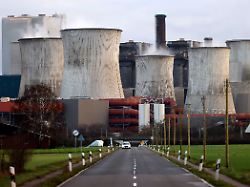Plan for hydrogen-capable plants
Gas power plant strategy determines date for coal phase-out
February 5, 2024, 4:14 p.m
Listen to article
This audio version was artificially generated. More info | Send feedback
The energy industry and business representatives breathe a sigh of relief: the traffic light coalition has managed to reach an agreement to promote gas power plants that can be operated with hydrogen. However, many questions remain unanswered, including the number of systems required. One of the Greens’ goals is almost impossible to achieve.
After a long struggle, the federal government has agreed on a compromise on the construction of new power plants. In total, new natural gas power plants with an initial output of ten gigawatts are to be built and subsidized with billions of dollars, as announced by the Chancellery, the Ministry of Economic Affairs and the Ministry of Finance. This corresponds to around 20 power plants. However, the economic department said that discussions were being held as to whether additional systems would be needed.
In 2032 it will be determined when the systems will be completely converted to hydrogen from 2035 onwards. It is therefore foreseeable that a CO2-free energy sector, which the Greens in particular are aiming for by 2035, is unlikely to be achieved. The government did not comment on the costs. In coalition circles it was said that the government estimates the costs to be around 16 billion euros for up to 20 years.
The energy industry and the economy reacted with relief that an initial agreement had finally been reached. “This is a crucial building block for a successful path towards climate neutrality while maintaining supply and system security,” said Kerstin Andreae, Managing Director of the Federal Association of the Energy Industry (BDEW). “Now there is an urgent need to create clarity for investors. The financing issue must be clarified just as quickly as the state aid security and the location issue.” The energy group Uniper said it expects to build some of the new capacity for Germany. “As soon as we have been able to examine the details, we will decide whether and with what investments we will participate,” said CEO Michael Lewis.
Tenders for the systems are planned
The German Environmental Aid (DUH) sharply criticized the agreement: The focus was on the construction of new fossil power plants. The conversion is unclear, and the systems probably do not have to be operated with hydrogen produced in a climate-neutral manner. It is an economic stimulus program for the natural gas lobby.
Finance Minister Christian Lindner and the FDP were also able to prevail on other issues: it was agreed that a so-called capacity mechanism should be in place by 2028. Billing is not based on the kilowatt hour, but the service provided is also compensated for, even if it is not needed. “A political agreement on this should be reached within the federal government by summer 2024 at the latest,” the government said. The parliamentary groups in the Bundestag should also be included in the debate about the electricity market design. However, such a system must be approved by the EU, which experience shows takes a very long time. Belgium, for example, took more than two years.
The option also remains open to use hydrogen, which, when produced with electricity from gas, for example, the carbon dioxide is previously separated and stored (CCS). The FDP vehemently advocates this CCS option, and Habeck also recently gave in regarding its use in industry. This should now also be possible directly with natural gas power plants. This is met with skepticism not only by the Greens, but also in the SPD. Tenders for the systems are planned: whoever requests the lowest subsidies will be awarded the contract. Operating without subsidies is uneconomical as the systems are unlikely to run much over the years. The majority of the electricity will come from wind and solar energy.
Power plant technology is increasingly supported in research
The cost estimates from the industry recently amounted to up to 40 billion euros by the mid-1930s, although around 30 gigawatts of output (around 60 power plants) were assumed. The Finance Ministry’s paper states that the tender volume is small compared to Economics Minister Robert Habeck’s original plans. “The expenditure now planned for public funding for new facilities will remain far below the Ministry of Economic Affairs’ original plans.” The most expensive types of power plants, which were supposed to run on 100 percent hydrogen from the start, no longer played a major role. In the industry, the costs were estimated at up to 40 billion euros for 30 gigawatts. For the ten gigawatts that have now been decided, this roughly corresponds to the aforementioned 16 billion euros.
In addition, modern power plant technology will be increasingly supported in research, according to the government paper. This should also include nuclear fusion. However, the Ministry of Economic Affairs stated that nuclear fusion does not play a role in the considerations for a climate-neutral future by 2045. Obstacles to the construction of electrolysis plants for the production of hydrogen should be eliminated and double burdens on electricity for storage and electrolysis should be avoided.
Planning and approval of the systems should be accelerated and the projects should be coordinated with the EU Commission. The government had struggled for months to reach an agreement. At its core, the planned strategy is about building gas power plants that are intended to compensate for the growing but fluctuating feed-in of wind and solar power. Gradually, the systems are to be converted to climate-friendly hydrogen, which is likely to be significantly more expensive than natural gas for a long time. Whether Germany can shut down the last coal-fired power plant by 2030, as demanded by the Greens in particular, also depends on the implementation of the strategy.
